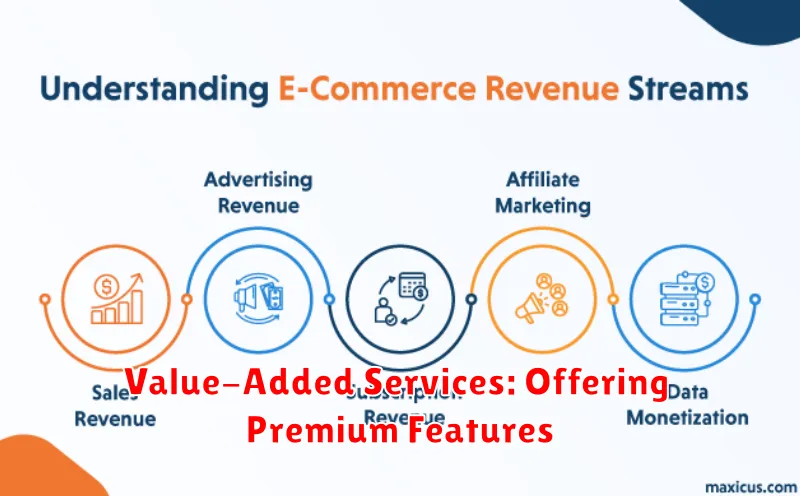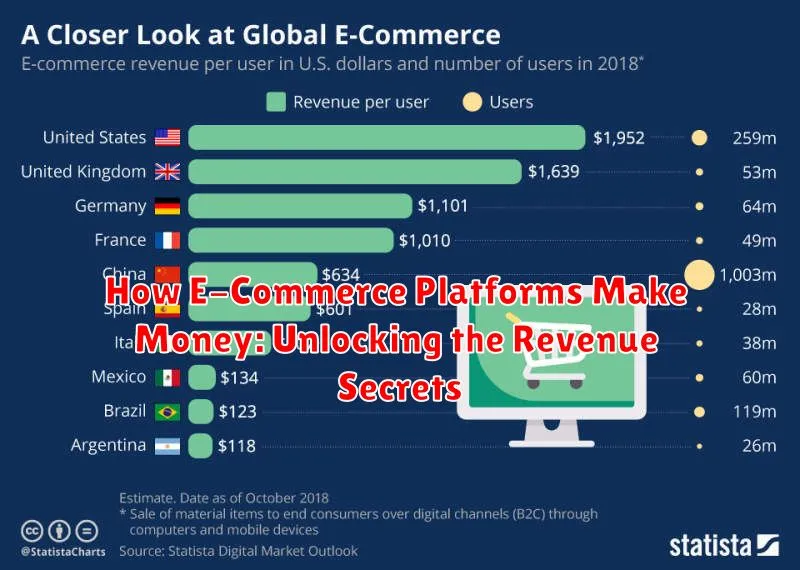Ever wondered how e-commerce platforms like Amazon, eBay, and Shopify generate such substantial revenue? The world of online retail is a complex ecosystem, and understanding how these platforms make money is crucial for both aspiring entrepreneurs and curious consumers. This article delves into the revenue secrets of e-commerce platforms, exploring the various monetization strategies they employ to achieve profitability. From transaction fees and subscription models to advertising revenue and value-added services, we will uncover the diverse ways these platforms capitalize on the booming e-commerce landscape.
Unraveling the revenue models of successful e-commerce platforms offers valuable insights into the inner workings of the digital marketplace. This knowledge can empower businesses to optimize their online presence, leverage platform features effectively, and ultimately drive growth. Whether you’re a seasoned online seller or just beginning your e-commerce journey, understanding how these platforms make money will provide a strong foundation for navigating the complexities of online retail and achieving e-commerce success. Join us as we unlock the revenue secrets behind the world’s most prominent e-commerce platforms.
Understanding the E-Commerce Business Model
At its core, the e-commerce business model facilitates the buying and selling of goods or services online. It eliminates the need for a physical storefront and expands market reach significantly. E-commerce platforms act as intermediaries, connecting buyers and sellers in a digital marketplace.
These platforms provide the necessary infrastructure for businesses to list products, manage inventory, process payments, and handle shipping. They create a streamlined experience for both merchants and consumers. The key components of a successful e-commerce business model are a user-friendly interface, secure transactions, efficient logistics, and effective marketing.
Different platforms cater to various business needs. Some specialize in specific product categories, while others offer a more general marketplace. Understanding the target audience and choosing the appropriate platform are crucial for success in the competitive e-commerce landscape.
Exploring the Different Revenue Streams for E-Commerce Platforms
E-commerce platforms employ a variety of strategies to generate revenue, ensuring their profitability and continued operation. Understanding these revenue streams is crucial for both businesses looking to sell online and investors interested in the e-commerce sector. Diversification of revenue streams is a key indicator of a platform’s stability and potential for growth.
Primarily, platforms earn through various models, including charging sellers for access to their marketplace, taking a percentage of each sale facilitated through their platform, and displaying targeted advertisements. Beyond these core methods, some platforms may also offer additional services like fulfillment or marketing support, creating further revenue opportunities.
The specific revenue mix for a platform depends on factors such as its size, target audience, and the types of products sold. Analyzing these revenue streams offers insights into the platform’s business model and its overall financial health.
Subscription Fees: Recurring Revenue for Platform Access

Subscription fees represent a predictable and stable income stream for e-commerce platforms. This model involves charging sellers a recurring fee, typically monthly or annually, for access to the platform’s infrastructure and services.
The subscription model offers several advantages for both the platform and the seller. For the platform, it provides a consistent revenue stream that can be used to invest in platform improvements and expansion. Sellers benefit from a predictable cost structure, enabling them to budget effectively. Subscription tiers often cater to different business sizes and needs, offering varying levels of features and support.
Subscription fees can vary based on several factors, including:
- Features offered: More comprehensive plans with advanced features often command higher fees.
- Sales volume: Some platforms tie subscription costs to sales volume, with higher sales resulting in higher fees.
- Level of support: Dedicated support or premium customer service might come at a premium subscription cost.
By offering various subscription tiers, platforms can cater to a wider range of sellers, from small startups to large established businesses.
Commission-Based Sales: A Percentage of Each Transaction
Commission-based sales represent a core revenue stream for many e-commerce platforms. This model involves charging sellers a percentage of each transaction completed on the platform. Essentially, the platform acts as a facilitator, connecting buyers and sellers and taking a cut of each successful sale.
The commission percentage can vary widely depending on the platform, the type of product sold, and the seller’s chosen plan. Lower-priced items might incur higher commission percentages, while higher-priced items often have lower rates. This structure allows the platform to generate revenue directly tied to sales volume.
This model incentivizes the platform to support seller success, as increased sales translate to higher platform earnings. It also provides a flexible and scalable revenue stream, automatically adjusting to fluctuations in market activity.
Advertising Revenue: Generating Income Through Targeted Ads
Advertising is a significant revenue stream for many e-commerce platforms. By leveraging the vast amount of user data they collect, these platforms can offer targeted advertising opportunities to businesses wanting to reach specific customer demographics.
This targeted approach allows vendors to display ads to users who have demonstrated interest in similar products or services, leading to higher conversion rates and a better return on investment for advertisers. The e-commerce platform earns revenue by charging advertisers for ad placements, impressions, or clicks, depending on the advertising model employed.
Several advertising formats are commonly used, including banner ads, sponsored product listings, and video ads. The platform carefully manages ad placement to maximize visibility without disrupting the user experience. This balance is crucial for maintaining a positive user experience while maximizing revenue potential.
Listing Fees: Charges for Product Listings
Listing fees represent a fundamental revenue stream for many e-commerce platforms. These fees are charged to sellers for the privilege of listing their products on the platform, essentially giving them access to the platform’s customer base. Listing fees can be structured in various ways.
Some platforms charge a flat fee per listing, regardless of the product’s price or quantity. Other platforms may implement a tiered fee structure, where the fee increases based on factors like the product category, listing duration, or the seller’s chosen plan. Subscription-based models are also common, offering sellers a set number of listings for a recurring monthly or annual fee.
Listing fees can be particularly important for platforms that specialize in unique or high-value items, such as antiques, collectibles, or art, where even a small percentage fee can generate substantial revenue. These fees offer a predictable income stream for the platform, even before transactions occur.
Value-Added Services: Offering Premium Features

E-commerce platforms often generate substantial revenue by offering optional value-added services to sellers. These premium features enhance visibility, streamline operations, and ultimately boost sales, making them attractive investments for businesses looking to gain a competitive edge.
Examples of such services include:
- Enhanced Listings: Options for bolder product displays, richer media integration, and strategic placement within search results.
- Fulfillment and Shipping Support: Streamlined logistics solutions, including warehousing, packaging, and shipping services, often at discounted rates.
- Marketing and Advertising Tools: Access to targeted advertising campaigns within the platform, promotional features, and data analytics dashboards for performance tracking.
- Customer Service Support: Platform-managed customer service assistance, freeing up sellers to focus on other aspects of their business.
- Shop Design and Customization: Tools and services to create visually appealing and branded storefronts, enhancing the customer experience.
Transaction Fees: A Cut of Each Sale
A primary revenue stream for e-commerce platforms is the transaction fee. This fee is a percentage of each sale facilitated through the platform, essentially a commission for connecting buyers and sellers. Transaction fees can vary depending on the platform, the product category, and sometimes even the seller’s sales volume.
These fees are often a small percentage, typically ranging from 1% to 5% of the total transaction value. However, considering the high volume of transactions processed daily, these small percentages accumulate to significant revenue for the platform. The rationale behind transaction fees is straightforward: the platform provides the infrastructure, marketing reach, and secure payment processing, so it takes a cut for enabling the sale.
Factors influencing transaction fees include the platform’s market share, the level of competition, and the services offered. Platforms with greater market dominance might charge higher fees due to their reach and established user base. Conversely, newer or niche platforms might offer lower fees to attract sellers and buyers.
Data Monetization and Analytics: Leveraging Platform Data
E-commerce platforms are treasure troves of data. Every click, search, purchase, and even abandoned cart provides valuable insights into consumer behavior. This data can be monetized in several ways.
Market research and insights: Aggregated and anonymized platform data can be packaged and sold to brands and retailers seeking a deeper understanding of market trends, competitor analysis, and customer preferences. This information helps businesses refine their marketing strategies, product development, and overall business decisions.
Targeted advertising: E-commerce platforms can offer targeted advertising services to sellers. By leveraging user data, platforms can display highly relevant ads to specific customer segments, increasing the effectiveness of advertising campaigns and maximizing return on investment for sellers. This allows the platform to charge premium prices for ad placements.

